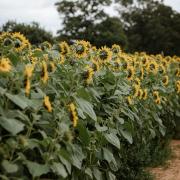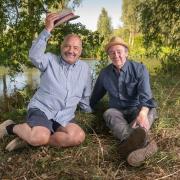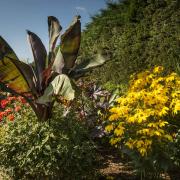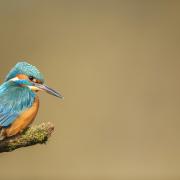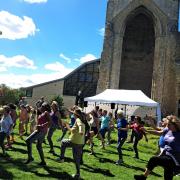This summer I’m raising grasshoppers. Teaching them to be good citizens, to put out their bins on the right day and pay their taxes, things like that. Well, no, actually I’m feeding them copious quantities of cock’s-foot grass, so they grow into strong and healthy grasshoppers, suitable for release into the wild next month.
There’s a backstory here. Two backstories really. The first is my own relationship with grasshoppers. In one way or another Orthoptera have been hopping through my mind and heart since I was 14. I was a lucky child, in that I encountered a biology teacher who opened my ears and eyes to the wild world and encouraged me to follow my passion for nature. He and his family remain dear friends to this day.
In the summer of 1988 this teacher and I learned together to identify grasshoppers, bush-crickets and groundhoppers. My mind was a sponge back then and in no time at all I knew all of Norfolk’s species by sight and – in the case of species which stridulate within the range of human hearing – by sound too. For well over 30 years I have known and loved the happy rattle of common green grasshoppers in spring’s meadows, the quiet purr of lesser marsh grasshoppers in summer’s long grass, and the muted chirp of dark bush-crickets from autumn’s brambles.
Much has changed since those days. Aided by climate change, two species – Roesel’s bush-cricket and the long-winged conehead – burst into Norfolk in the 1990s and quickly became abundant in rank grassland. A third species, the southern oak bush-cricket, has colonised much more recently, also thanks to climate change. Living in broad-leaved trees and communicating by drumming its feet on leaves at pitches above the range of human ears, it is hard to detect and may be more abundant than we realise.
A fourth species – the great green bush-cricket – was vanishingly rare in Norfolk in my childhood. But in the past couple of years it has been found at several new sites across the county. Orthoptera, it would seem, may be among the winners for as long as climate change makes Norfolk warmer.
In the beautifully illustrated field guide from which my teacher taught me grasshoppers and bush-crickets in the 1980s there were plenty of species not found in Norfolk. Most were restricted to the south coast of England, but one – the very handsome large marsh grasshopper – had been present in Norfolk until well into the 20th century.
And this is the other backstory. These are the grasshoppers I’m raising this summer. All across East Anglia, in fact, likeminded people are raising large marsh grasshoppers to be released into the wild, following a meticulous scientific protocol. This amazing project – to restore the large marsh grasshopper to historic haunts in Norfolk and eventually across East Anglia – is led by a small, dynamic conservation organisation called Citizen Zoo. For the past few years, with consent from Natural England and the Forestry Commission, entomologists and conservationists from Citizen Zoo have collected small (and carefully calculated) numbers of large marsh grasshoppers from their few remaining UK sites in the New Forest.
These adults are kept in captivity, where they breed. Their eggs are then distributed to trained volunteer keepers across East Anglia. Together these committed volunteers can raise incomparably more juvenile hoppers than the adults could if they were released directly in Norfolk. In late summer, two waves of resulting large marsh grasshopper youngsters are released into well-managed wetlands in the county.
In this way, large marsh grasshoppers have been re-established by a small, ambitious NGO – with a brilliant model for engaging people – as a breeding species in Norfolk. One of the sites where they breed, and where they continue to be released, has been cared for, and restored over many years, by Norfolk Wildlife Trust. We manage this precious place for all its wildlife, including countless rare species, some of which are found nowhere else in lowland England. But now it is home to a very rare grasshopper too, whose loud ticking stridulation had last been heard in Norfolk decades ago.
This is the very best of conservation. The project unites sensitive land management and restoration (on all three Norfolk sites where the grasshopper has been released); rigorous scientific guidance; strong partnership between government agencies, conservation NGOs and private landowners; and – best of all – the enthusiasm and dedication of ordinary people who want to see a wilder, greener, better world.
It may seem a small thing. After all, it’s just an inch-long grasshopper which lives its whole life in the squelchy places hardly anyone visits. But for us it is a triumph, a model of how – working together – communities and conservationists can change the world.
And we must change the world. For centuries, in this country and, increasingly, all across the planet, we have eroded the natural world around us. Around us? No. The natural world within us: in our lungs, in our bellies, in our veins, in our ears, in our eyes and in our hearts. We come from nature. We depend on nature. We are nature. And without nature we ourselves will not survive.
The grasshopper project, in which Norfolk Wildlife Trust is delighted to collaborate with Citizen Zoo and others, is called A Hop of Hope. Each grasshopper, quietly munching grass downstairs as I write, is a small ambassador for a hopeful future. It is a tiny chitinous promise that our society can and will do better.
We can do better. For our own sake we must do better. But it will take visionary ideas and careful science. It will take determined professional conservationists and armies of engaged, committed and creative citizens. Including you.
It begins with the small chirp of a rare grasshopper on a late summer day. But soon it’s a passion for turning the tide, for bringing the wild back everywhere, without and within. It’s the ride of our lives and the time is now.
It starts with a grasshopper. Are you in?






